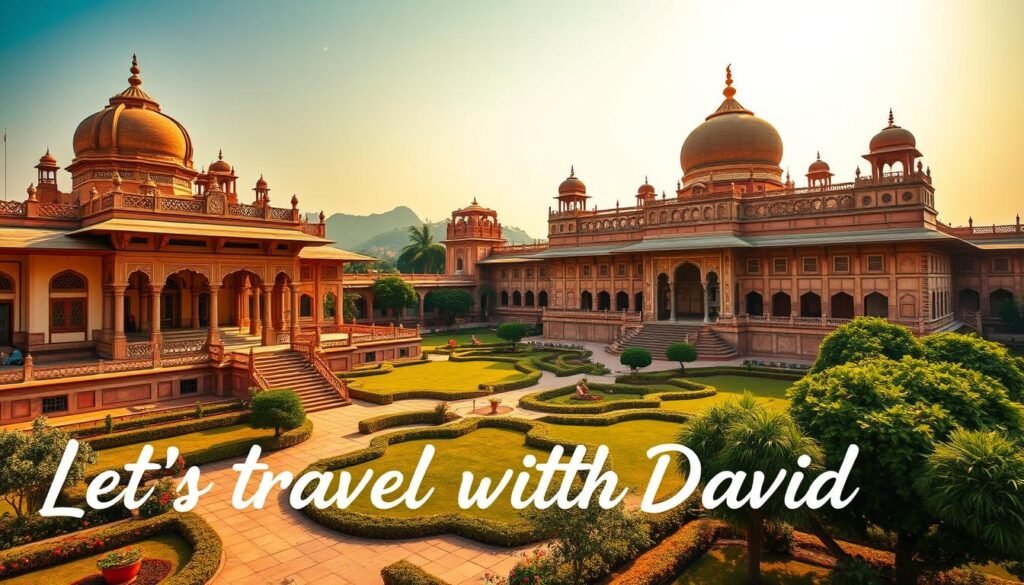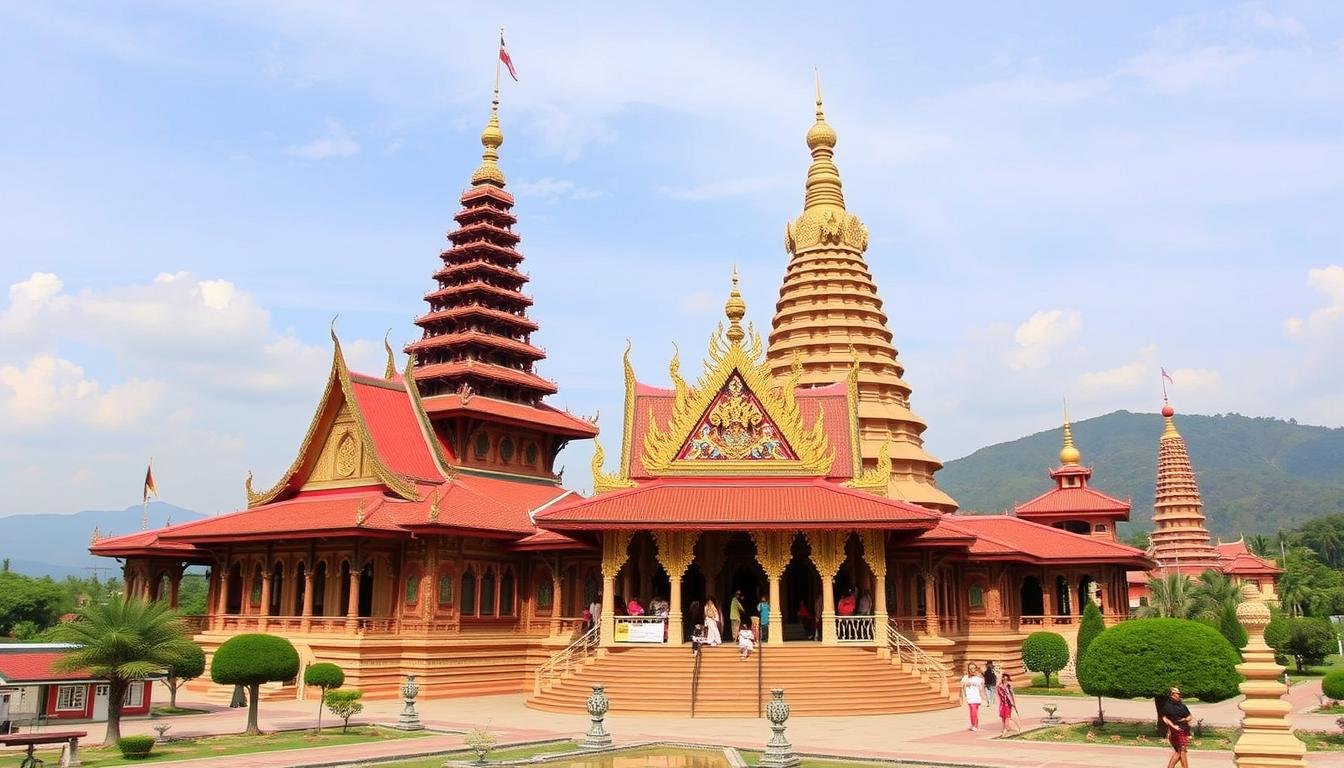Looking at Asia’s cultural heritage fills me with awe and respect. The continent is full of ancient temples and peaceful gardens. These places have amazed travelers for centuries.
Asia’s cultural treasures are a mix of amazing buildings and preserved traditions. They let you dive into human history like never before. We’ll explore Asia’s most iconic spots and hidden gems in this article. Together, they tell a story of strength, creativity, and lasting beauty.
Key Takeaways
- Discover the most awe-inspiring cultural sites and iconic landmarks across Asia.
- Gain insights into the historical significance and architectural brilliance of these treasures.
- Explore the diverse cultural heritage that has shaped the continent’s rich tapestry.
- Uncover the modern conservation efforts to preserve these invaluable assets for future generations.
- Immerse yourself in the timeless traditions and captivating stories that bring these cultural wonders to life.
Cultural Treasures Cultural Sites Top Heritage Iconic Landmarks in Asia
Asia is a vast and diverse continent. It has a rich cultural heritage that spans millennia. From towering sacred monuments to ancient temple complexes, these sites offer a glimpse into the region’s captivating past.
Understanding Asia’s Rich Cultural Heritage
Asia’s cultural legacy is deeply rooted in the traditions and beliefs of its many civilizations. For centuries, these sacred sites have served as centers of spiritual, artistic, and architectural significance. They reflect the ingenuity and reverence of their creators.
From the grand temples of India to the serene monasteries of Tibet, these UNESCO World Heritage sites are a testament to the region’s unwavering commitment to preserving its cultural identity.
The Significance of Preserving Ancient Sites
These ancient cultural treasures hold immense value. They are not just for their historical significance but also for their ability to inspire and educate future generations. By safeguarding these sacred monuments, we can ensure that their stories and legacies continue to be shared.
This fosters a deeper understanding and appreciation of Asia’s rich cultural heritage.
Modern Conservation Efforts
Across Asia, dedicated efforts are underway to preserve and protect these invaluable cultural sites. Through innovative conservation techniques, international cooperation, and community engagement, stakeholders are working tirelessly to restore and maintain the integrity of these world heritage sites.
By embracing sustainable practices and embracing the significance of these cultural treasures, we can ensure that they remain intact for generations to come.
| World Heritage Site | Country | Significance |
|---|---|---|
| Angkor | Cambodia | Renowned for its magnificent temple complexes, including the iconic Angkor Wat, this site exemplifies the grandeur of the Khmer civilization. |
| Potala Palace | Tibet, China | The former residence of the Dalai Lamas, this architectural marvel is a symbol of Tibetan Buddhist heritage and spirituality. |
| Taj Mahal | India | An iconic symbol of love and one of the most recognizable landmarks in the world, the Taj Mahal is a stunning example of Mughal architecture. |
As we explore the cultural treasures of Asia, we are reminded of the enduring power of these sacred monuments to captivate and inspire. Through ongoing preservation efforts, we can ensure that these world heritage sites continue to thrive. They will preserve the rich tapestry of Asia’s cultural legacy for generations to come.
“These ancient sites are not just relics of the past, but living, breathing testaments to the ingenuity and resilience of the human spirit.”
Ancient Temples of Angkor: Cambodia’s Crown Jewel
The Angkor Archaeological Park is a treasure in the Cambodian jungle. It’s filled with ancient ruins, marvels, and stunning Buddhist temples. This UNESCO World Heritage Site is famous for the magnificent Angkor Wat, a gem of Cambodia’s culture.
Angkor Wat is the biggest religious monument globally. It shows the skill and creativity of the Khmer Empire. Built in the 12th century, it mixes Khmer and Indian styles, creating a stunning sight for centuries.
The park has many ancient temples, each with its own story. You can see the Bayon Temple with its smiling faces or visit Beng Mealea, a hidden gem. These temples are not just impressive; they’re also sacred.
These sites are more than just engineering wonders. They were key to the Khmer Empire’s culture and religion. Visitors can feel the calm and learn about Cambodia’s heritage.
It’s crucial to protect these sites for future generations. Local and international groups work hard to keep them safe. Their efforts help preserve Cambodia’s history and pride.
“Angkor Wat is one of the most important archaeological sites in Southeast Asia. It is the largest religious monument in the world and represents the highest point of Khmer architecture and one of the greatest cultural achievements in human history.”
Sacred Buddhist Monasteries of Tibet and Nepal
Explore the spiritual heart of Asia in Tibet and Nepal. These places are filled with Buddhist monasteries that show the area’s rich culture. They mix amazing architecture with deep spiritual meaning.
Potala Palace’s Architectural Marvel
The Potala Palace in Lhasa is a stunning sight. It was once home to the Dalai Lamas. Its walls, painted red and white, hide chapels, prayer halls, and meditation rooms. Each place feels peaceful and full of respect.
Spiritual Significance of Tibetan Monasteries
Tibetan monasteries are more than beautiful buildings. They are the spiritual center of the area. They hold Buddhist teachings, meditation, and rituals. Visitors can hear monks chant, see beautiful art, and learn about deep spiritual traditions.
Nepal’s Ancient Buddhist Heritage
In the Kathmandu Valley, Nepal’s monasteries show its rich culture. The Boudhanath Stupa is a huge white dome. The Swayambhunath Stupa, or “Monkey Temple,” offers stunning views. These sites connect us to Nepal’s spiritual wisdom and culture.
| Location | Iconic Buddhist Monument | Architectural Style | Spiritual Significance |
|---|---|---|---|
| Lhasa, Tibet | Potala Palace | Tibetan and Nepalese | Former residence of Dalai Lamas, center of Tibetan Buddhism |
| Kathmandu Valley, Nepal | Boudhanath Stupa | Nepalese Newari | One of the largest Buddhist stupas in the world, a UNESCO World Heritage Site |
| Kathmandu Valley, Nepal | Swayambhunath Stupa | Nepalese Newari | Ancient Buddhist site, also known as the “Monkey Temple” for the resident monkeys |
“The monasteries of Tibet and Nepal are not just architectural marvels, but living embodiments of the region’s profound spiritual tradition. They invite us to step into a world of timeless wisdom and contemplation.”
The Great Wall of China: A Testament to Human Perseverance
The Great Wall of China stretches over 13,000 miles. It’s one of the world’s most iconic landmarks. It shows the ingenuity and determination of the Chinese people.
This massive wall was built over centuries. It’s a symbol of China’s ancient civilization and its lasting legacy.
Building the Great Wall was a huge engineering challenge. Thousands of workers from different dynasties worked on it. The wall was made from stone, brick, and earth to protect China’s borders.
The project’s scale and complexity are amazing. It continues to amaze and inspire people from all over the world.
The Great Wall of China is also a cultural and historical treasure. It’s a UNESCO World Heritage site. Its path through rugged terrain shows China’s rich history and the people’s ingenuity.
Today, the Great Wall is a symbol of China’s spirit. Millions visit each year to see its grandeur. They want to connect with its stories. The Great Wall is a must-see for those exploring cultural treasures of Asia.

“The Great Wall of China is a marvel of human engineering and a testament to the enduring spirit of the Chinese people.”
Japan’s Historic Kyoto: Where Tradition Meets Elegance
Kyoto, Japan’s former imperial capital, is a goldmine of heritage sites. It shows Japan’s lasting traditions. The city is filled with imperial palaces, Zen Buddhist temples, beautiful gardens, and tea houses. All these reflect Japan’s beauty and grace.
Imperial Architecture and Gardens
The Nijo Castle in Kyoto is a UNESCO World heritage site. It’s famous for its stunning architecture and the Ninomaru Palace. Inside, the “nightingale floors” and the Ninomaru Garden give a peek into Japan’s imperial history.
Zen Buddhist Temples
Kyoto boasts some of Japan’s most sacred Buddhist temples. The Golden Pavilion, or Kinkakuji, is a standout. Its gold leaf exterior glimmers in the pond, creating a peaceful scene.
Traditional Tea Houses
Visiting Kyoto isn’t complete without the traditional Japanese tea ceremony. The city’s tea houses, like those in Gion, let you dive into this ancient tradition. Here, making and serving tea is an art form.
“Kyoto is a city that seamlessly blends the old and the new, where the essence of Japan’s cultural identity is preserved and celebrated.” – [Author’s Name]
In Kyoto, you can marvel at the imperial palaces, find peace in the Buddhist temples, or enjoy the tea ceremony. These cultural wonders will touch your heart and mind deeply.
India’s Golden Triangle: Architectural Wonders
The Golden Triangle in India is a visual treat. It includes Delhi, Agra, and Jaipur, each with its own historic gems. These cities are home to some of India’s most famous landmarks, showing off the region’s rich history and UNESCO World Heritage sites.
The Taj Mahal is a highlight in this area. It’s a stunning example of Islamic architecture that draws visitors from everywhere. Built by Shah Jahan for his wife, it symbolizes the power of love and skill.
But there’s more to see than just the Taj Mahal. In Delhi, the Red Fort and Humayun’s Tomb show off the area’s historic palaces. Jaipur’s Amber Fort is another UNESCO site, known for its detailed carvings and views.
These landmarks, along with many others, make the Golden Triangle a key place to visit. It offers a deep dive into India’s culture, from its grand palaces to its impressive mosques. This region is a window into India’s past and its lasting legacy of Islamic architecture.

Islamic Architecture in Central Asia
The ancient cities along the Silk Road in Central Asia are famous for their stunning Islamic architecture. Places like Uzbekistan’s grand mosques and the detailed tilework on religious monuments show the beauty of Islamic design. This region is full of cultural treasures and archeological marvels.
Uzbekistan’s Ancient Silk Road Cities
Samarkand, Bukhara, and Khiva in Uzbekistan are true gems of Islamic architecture. These cities have impressive structures like the Registan in Samarkand. It’s a group of three beautifully decorated madrasas (Islamic schools).
The Bibi-Khanym Mosque and the Gur-e Amir Mausoleum are also highlights. Their blue-tiled domes and minarets show the region’s architectural brilliance.
Persian Influence on Asian Architecture
The Islamic architecture in Central Asia shows a clear Persian influence. You can see intricate tilework, pointed arches, and domed roofs. These features reflect the shared cultural heritage between Persia and the Turkic peoples of the Silk Road.
This mix of styles has created a unique architectural language. It’s both visually stunning and deeply rooted in the region’s history.
Religious Monuments and Mosques
- The Bibi-Khanym Mosque in Samarkand is one of the largest and most impressive mosques in Central Asia. It has a towering portal and ornate tile decorations.
- The Kalyan Minaret in Bukhara stands over 47 meters tall. It’s a remarkable example of Islamic architecture’s technical mastery and artistry.
- The Shah-i-Zinda necropolis in Samarkand is a collection of mausoleums and mosques. It shows the region’s reverence for religious and cultural heritage.
From Uzbekistan’s iconic monuments to the hidden gems along the Silk Road, Central Asia’s Islamic architecture is a testament to its rich cultural treasures and archeological marvels.
Southeast Asian Temple Complexes
In Southeast Asia, you’ll find amazing ancient ruins and Buddhist temples that are UNESCO World Heritage sites. These sites show the area’s rich culture and draw visitors from everywhere.
The Borobudur in Indonesia is a top spot. It’s the biggest Buddhist temple complex in the world. Built in the 9th century, it has over 2,000 panels and 72 stupas with Buddha statues. Climbing its terraces, you see incredible carvings and views of volcanoes.
Myanmar’s Bagan is another must-see ancient ruin. It has over 2,200 temples, pagodas, and monasteries from the 11th and 12th centuries. Walking through, you see the unique Burmese Buddhist architecture and learn about the area’s traditions.
The city of Ayutthaya in Thailand is also historic. It was the capital of Siam for over 400 years. Its ruins, now a UNESCO World Heritage site, show the Thai people’s skill and culture. Visiting, you feel the lasting impact of Southeast Asia’s architecture and spirituality.
“The temple complexes of Southeast Asia stand as timeless reminders of the region’s rich cultural tapestry, inspiring awe and wonder in all who experience their timeless beauty.”
Conclusion
Exploring Asia’s cultural treasures shows us a vast continent rich in heritage. From Angkor’s ancient temples in Cambodia to Central Asia’s Islamic architecture, Asia’s history is woven into its landscapes. These cultural sites and top heritage landmarks tell stories of Asian civilizations’ strength and creativity.
It’s crucial to protect these cultural treasures and iconic landmarks in Asia. This way, future generations can marvel at these wonders. By conserving these sites, we honor Asia’s cultural legacy and promote understanding and respect for its diverse histories.
When planning your next trip, consider exploring Asia’s cultural wonders. Dive into its landscapes, architecture, and spiritual depth. This journey not only broadens your perspective but also helps preserve Asia’s cultural heritage for all to enjoy.
